

An Environmentalist on the Lie of Locavorism. A small farm in Woodside, Queens, grows vegetables along the right-of-way of the Long Island Railroad.
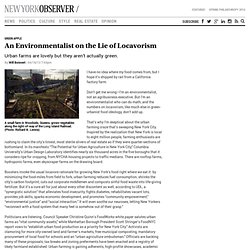
(Photo: Richard B. Levine) I have no idea where my food comes from, but I hope it’s shipped by rail from a California factory farm. Don’t get me wrong—I’m an environmentalist, not an agribusiness executive. But I’m an environmentalist who can do math, and the numbers on locavorism, like much else in green-urbanist food ideology, don’t add up.
Substrat. Empreinte écologique. Jardin sur toit. Gratte-ciel agricole. Jardin vertical. Aquaponie. Manger local, une utopie concrète. Marché aux légumes, Ankara (cc) muammerokumus Dans un article récent publié dans Métropolitiques, Roland Vidal (2011) dénonce tout à la fois l’irréalisme des propositions visant à nourrir les grandes métropoles urbaines à partir d’une agriculture de proximité et le caractère erroné de l’affirmation selon laquelle la proximité serait plus écologique, car plus économe en énergie consacrée aux transports.
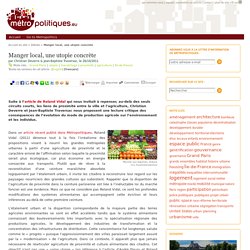
Plutôt que de rêver à la reconstitution d’une ceinture maraîchère absorbée logiquement par l’étalement urbain, il invite les citadins à reconstruire leur regard sur les paysages nourriciers des grandes cultures qui subsistent. Rappeler que la disparition de l’agriculture de proximité dans la ceinture parisienne est liée à l’inéluctable loi du marché foncier est une évidence. Mais ce que ne considère pas Roland Vidal, ce sont les profondes modifications des systèmes alimentaires qui accompagnent cette éviction et leurs inférences au-delà de cette première ceinture. Quand l’agriculture s’installe en ville… Permaculture urbaine.
TEDxParis 2012 - Augustin Rosenstiehl - L'agriculture urbaine. Carolyn Steel : Comment la nouriture façonne nos villes. 'Vertical farm' blossoms at meatpacking plant. Greens and mushrooms grown at the Plant with homemade sauce and bread by Carla, the plant's mycologist.
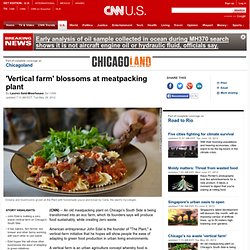
John Edel is building a zero waste veritcal farm on Chicago's South SideIt has bakers, fish farmer, tea brewer and other farms working with each other to use wasteEdel hopes this will show other businesses the ease of adapting to green initiatives. Plantagon Breaks Ground on its First 'Plantscraper' Vertical Farm in Sweden! Several years ago a Swedish-American company called Plantagon unveiled plans for a series of massive skyscraper greenhouses that stood to transform urban farming in large cities.
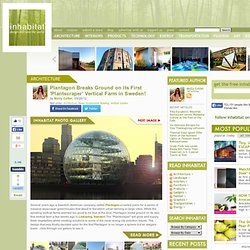
While the spiraling vertical farms seemed too good to be true at the time, Plantagon broke ground on its very first vertical farm a few weeks ago in Linkoping, Sweden! The "Plantscraper" will grow and supply fresh vegetables while creating solutions to some of the most vexing city pollution issues. The design that was finally decided upon for the first Plantagon is no longer a sphere but an elegant tower - click through our gallery to see it. Plantagon seems to have traded in its initial geodesic dome design for a sheer tower that both contains and showcases the plants growing inside. An Off-Grid Vertical Farm for Downtown Seattle. 4.bp.blogspot.com/_Ymx9e66vrGc/S_BUyWbEWPI/AAAAAAAAMO8/5KAt_lOli9s/s1600/draft_greenhousemodel_1.jpg. Vertical Garden - Vertical Farm. The Vertical Farm Project - Agriculture for the 21st Century and Beyond. Beehive Tower is a Honeycomb Inspired Vertical Farm for London.
The aim of the Beehive Tower is to provide the Canary Wharf community of city dwellers a place to garden and live.

The tower’s hexagonal mega structural lattice contains greenhouse spaces that also serve as a place for people to meet and socialize. Each hexagon is 8 stories high and contains 8 duplex apartments. A number of the hex cavities are dedicated to gardening and face in different directions so that each element gets a fair share of sun. Atop the tower, fourteen Quiet Revolution QR12 turbines collect enough wind to generate 420,000kWh a year. In addition, rainwater collection and permaculture systems would make the watering needs of the tower sustainable.
Urban farming. Studiomobile: seawater vertical farm. Mar 05, 2009 studiomobile: seawater vertical farm ‘seawater vertical farm’ by studiomobile image courtesy studiomobile during the last two years italian architectural firm studiomobile have been working in the united arab emirates, developing housing projects and infrastructure projects.
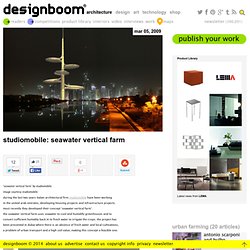
Riaus.org.au/wp-content/uploads/2012/02/The-Living-Skyscraper-Farming-thel-Urban-Skyline-by-Blake-Kurasek.jpg. THE FUTURE OF THE FOOD SUPPLY IN THE CITY REVISITED: IS VERTICAL FARMING (AT THE PRECIOUS HEART OF THE CITY) A GREENER AND ALTERNATIVE WAY TO PRODUCE FOOD? NOW, AFTER TRIALS AND ERRORS, THE IDEA IS ABOUT TO BE PROVEN. “An indoor farmer doesn’t pray for rain”.
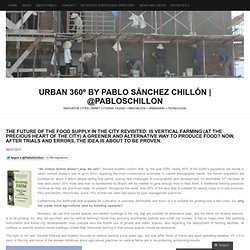
Several studies confirm that, by the year 2050, nearly 80% of the Earth’s population will reside in urban centers (today’s rate is up to 60%). Applying the most conservative estimates to current demographic trends, the human population will increase by about 3 billion people during that period, posing new challenges to sustainability and development. An estimated 109 hectares of new land (about 20% more land than is represented by Brazil) will be needed to grow enough food to feed them, if traditional farming practices continue as they are practiced today. At present, throughout the world, over 80% of the land that is suitable for raising crops is in use (sources: FAO and NASA). Historically, some 15% of that has been laid waste by poor management practices.
Furthermore, the additional land available for cultivation is unevenly distributed, and much of it is suitable for growing only a few crops. The topic is not new. Growing up - is vertical farming the future? Are high rise farms, vertical farming, and urban farming the solution to feeding our growing population?
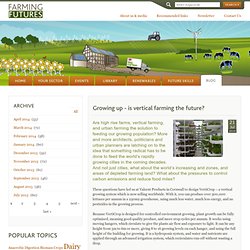
More and more architects, politicians and urban planners are latching on to the idea that something radical has to be done to feed the world’s rapidly growing cities in the coming decades. And not just cities, what about the world’s increasing arid zones, and areas of depleted farming land? What about the pressures to control carbon emissions and reduce food miles? These questions have led us at Valcent Products in Cornwall to design VertiCrop – a vertical growing system which is now selling worldwide. With it, you can produce over 500,000 lettuces per annum in a 250m2 greenhouse, using much less water, much less energy, and no pesticides in the growing process. Because VertiCrop is designed for controlled environment growing, plant growth can be fully optimised, meaning good quality produce, and more crop cycles per annum. Examples of Container Gardening, Raised Bed Garden, Vertical Tower Garden at the Great Park. Www.evolo.us/wp-content/uploads/2010/04/vertical-farm-2.jpg.
Interview With The Father Of Vertical Farming – Dr. Dickson Despommier. This is a community post, untouched by our editors.
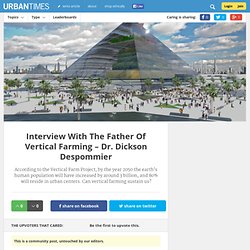
According to the Vertical Farm Project, by the year 2050 the earth’s human population will have increased by around 3 billion, and 80% will reside in urban centers. The project estimates 109 hectares of new land (about 20% more land than the area of Brazil) will be needed to grow enough food to feed them, if traditional farming practices continue as they are practiced today. Though at its core, the project asks; “How are we to avoid this impending disaster”? The man behind this project, Dr. Dickson Despommier, believes the answer is simple – farm vertically. Dr. Former Columbia professor Dr. I spoke to him from his home in New Jersey. VINCENT CALLEBAUT ARCHITECTE C.V.